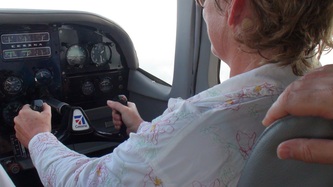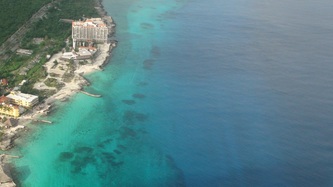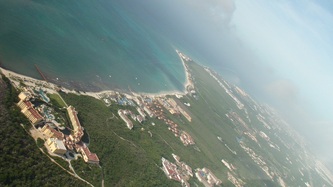The Rhincodon typus whale shark is the world's largest fish; it has traveled the oceans of this world and has a history of 60 million years. Moreover, the shark is extraordinary for the reason that not only is it the only living species of its genus but also of its family.
Nonetheless, we certainly know little about this species which is documented vulnerable in the IUCN list. The first whale shark measuring 4.6 meters was identified, speared and captured on the shores of Table Bay, South Africa in 1828. The caught whale shark was sold for six pounds and its holotype is displayed at the Museum of Natural History in Paris. One year following to this fantastic discovery the very first scientific paper about this species was written, and in 1849 the first complete description of the whale shark was written and published. Owing to the fish's physiology that it was given the name whale shark; a shark with the visual appeal and size more like that of a whale.
The whale shark is an aloof fish which sometimes forms groupings to feed in areas with large food concentrations. Males can be found in different places while females prefer to stay in specific areas. Its belly is white and his back is a darker gray than other sharks and has a lot of dots and horizontal and vertical white or yellow lines. These dots signify a distinctive pattern in each specimen, which explains why they're utilized for identification purposes and to census the population.There are several theories on the purpose of these spots: They might be used for camouflage, as from below they can easily be confused with the light from the sky and from above they can be confused with the reflection of exterior light. Another chance is that these distinct marks are a social feature for knowing other sharks or that the freckling patterns are an adaptation to safeguard the shark from radiation, which is significant for species that keep a significant part of their time on the water surface. An interesting side note on the coloring of the whale shark's skin is that in 2007 Antonio Moreano photographed a rare albino specimen in the northern zone of the Galapagos Islands.
Because whale sharks have a robust and lengthened body which is holding a number of longitudinal ridges on the head and back makes them hydrodynamic animals. The skin of a whale shark can get as thick as 10 cm. Its head is broad and flattened; its eyes are small and are located on the sides. They have spiracles behind the eyes; respiratory openings that permit contact between the air or water and the internal respiratory system. The placement of its eyes creates vision of way less importance compared to smell. Their mouth can be as huge as 1.5 meters wide. Whale sharks have about 3000 teeth in each jaw, yet these are tiny (a lot less than 6mm in length) and usually are not employed for feeding. It has five pairs of large gill slits which clefts are enormous. It has a pair of dorsal fins and pectoral fins. Its tail can measure more than 2.5 meters from side to side. The tail of an adult has a half moon shape and provides the propulsion; the upper part of the tail of younger species is larger than the lower part. They are utilizing their entire body to be able to swim, a particular thing that is not very usual in fish and that make it a less proficient swimmer. The shark won't reach a greater speed than 5 km/h; a reasonably slow speed for a fish of such gigantic size. It is thought that they can grow 20 m in length and they don't reach sexual maturity until they measure over 9 meters (at 30 years more or less). They can weigh up to 34 tons (34000 kg). They are thought to live an average of 60 years, might be more. Though first considered to be viviparous, and then assumed to be oviparous, in the year 1996 it was found out that they are ovoviparous (the eggs keep on being inside the female until eventually hatching), when a female with 300 eggs was encountered; the most significant number of eggs recorded in any types of shark.Newborn whale sharks normally reach between 40 and 60 centimeters in length, despite the fact that little is noted about them.
Eager to see a whale shark yourself? Visit the whale shark tours page.
You may also be interested taking a look at the other adventure excursions we have.
Nonetheless, we certainly know little about this species which is documented vulnerable in the IUCN list. The first whale shark measuring 4.6 meters was identified, speared and captured on the shores of Table Bay, South Africa in 1828. The caught whale shark was sold for six pounds and its holotype is displayed at the Museum of Natural History in Paris. One year following to this fantastic discovery the very first scientific paper about this species was written, and in 1849 the first complete description of the whale shark was written and published. Owing to the fish's physiology that it was given the name whale shark; a shark with the visual appeal and size more like that of a whale.
The whale shark is an aloof fish which sometimes forms groupings to feed in areas with large food concentrations. Males can be found in different places while females prefer to stay in specific areas. Its belly is white and his back is a darker gray than other sharks and has a lot of dots and horizontal and vertical white or yellow lines. These dots signify a distinctive pattern in each specimen, which explains why they're utilized for identification purposes and to census the population.There are several theories on the purpose of these spots: They might be used for camouflage, as from below they can easily be confused with the light from the sky and from above they can be confused with the reflection of exterior light. Another chance is that these distinct marks are a social feature for knowing other sharks or that the freckling patterns are an adaptation to safeguard the shark from radiation, which is significant for species that keep a significant part of their time on the water surface. An interesting side note on the coloring of the whale shark's skin is that in 2007 Antonio Moreano photographed a rare albino specimen in the northern zone of the Galapagos Islands.
Because whale sharks have a robust and lengthened body which is holding a number of longitudinal ridges on the head and back makes them hydrodynamic animals. The skin of a whale shark can get as thick as 10 cm. Its head is broad and flattened; its eyes are small and are located on the sides. They have spiracles behind the eyes; respiratory openings that permit contact between the air or water and the internal respiratory system. The placement of its eyes creates vision of way less importance compared to smell. Their mouth can be as huge as 1.5 meters wide. Whale sharks have about 3000 teeth in each jaw, yet these are tiny (a lot less than 6mm in length) and usually are not employed for feeding. It has five pairs of large gill slits which clefts are enormous. It has a pair of dorsal fins and pectoral fins. Its tail can measure more than 2.5 meters from side to side. The tail of an adult has a half moon shape and provides the propulsion; the upper part of the tail of younger species is larger than the lower part. They are utilizing their entire body to be able to swim, a particular thing that is not very usual in fish and that make it a less proficient swimmer. The shark won't reach a greater speed than 5 km/h; a reasonably slow speed for a fish of such gigantic size. It is thought that they can grow 20 m in length and they don't reach sexual maturity until they measure over 9 meters (at 30 years more or less). They can weigh up to 34 tons (34000 kg). They are thought to live an average of 60 years, might be more. Though first considered to be viviparous, and then assumed to be oviparous, in the year 1996 it was found out that they are ovoviparous (the eggs keep on being inside the female until eventually hatching), when a female with 300 eggs was encountered; the most significant number of eggs recorded in any types of shark.Newborn whale sharks normally reach between 40 and 60 centimeters in length, despite the fact that little is noted about them.
Eager to see a whale shark yourself? Visit the whale shark tours page.
You may also be interested taking a look at the other adventure excursions we have.





 RSS Feed
RSS Feed